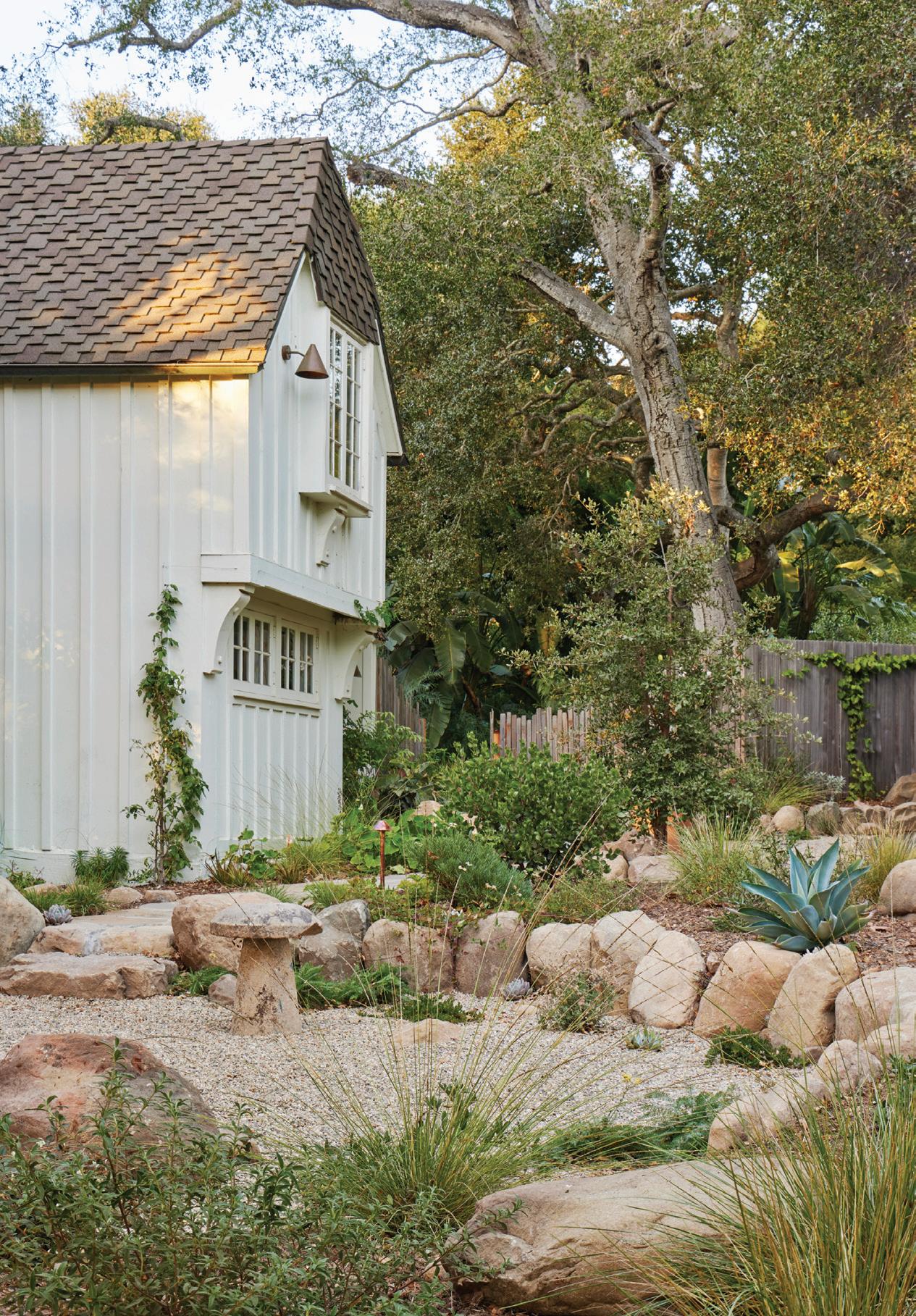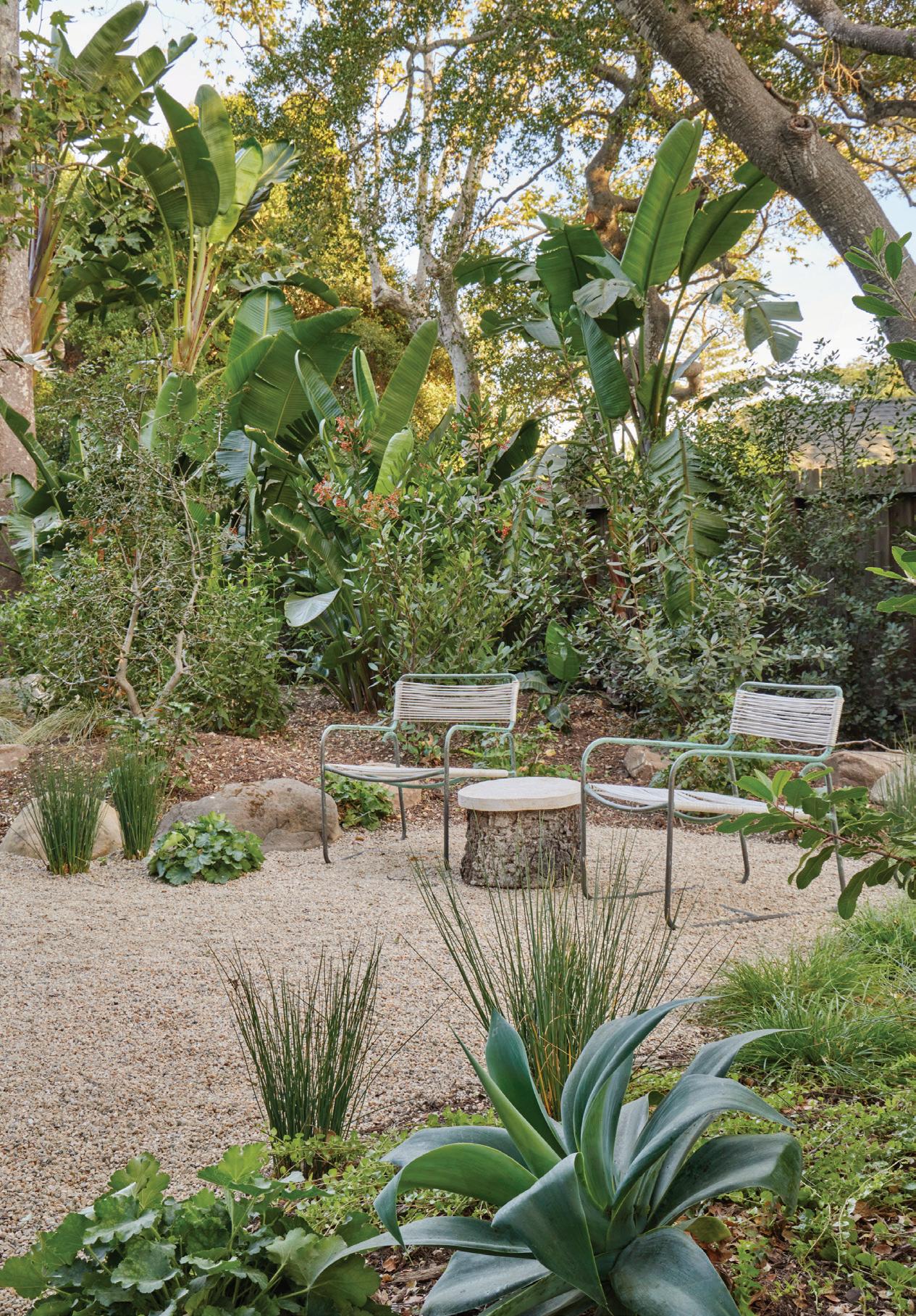
7 minute read
Rooted in Beauty: A Native Garden Flourishes in Santa Barbara
By Jenny McClure, Senior Donor Relations Manager
Nestled in the foothills of Santa Barbara, where golden light spills across the landscape and coastal breezes weave through the canyons, lies a garden that feels like a world unto itself — an English garden in spirit but undeniably Californian at heart. It is a space brimming with abundance and lushness, where native plants weave together to create an atmosphere both enchanting and deeply rooted in place. This is the home garden of Ranney Draper and Eric Roinestad, a testament to the transformative power of native plants.
As we sit together, surrounded by an expertly cultivated landscape formed from intention and artistry, I ask Ranney how this garden came to be — how they envisioned a space that would not only be beautiful but also resilient, ecologically rich, and a true extension of Santa Barbara’s natural landscape.

Designing With Nature
“It started with a love of gardens, really,” Ranney tells me. “We knew we wanted something that felt layered and abundant.” Their charming house is an original Moody cottage, one of a handful of storybook-like homes built in Santa Barbara and Montecito by the Moody sisters in the 1930s and 1940s. The couple wanted their landscape to keep with the architectural style — welcoming, immersive, whimsical, and something you could get lost in. At the same time, they wanted a garden that worked with the natural landscape, using minimal water and without requiring constant intervention.
The solution lay in native plants — species uniquely adapted to the rhythms of this land and able to thrive in the coastal air, the shade of the oaks (Quercus spp.), and the California climate. “We started visiting Santa Barbara Botanic Garden and were able to get a sense of what was possible,” Ranney explained. “We would wander with friends and see just how diverse and beautiful native plants could be.”
With help from their landscape architect, Courtney Jane Miller of CJM::LA, they began designing a garden that borrowed from the structure of traditional English gardens — curving pathways with special nooks and seating areas, varied textures, layered plantings, and pots, lots of pots. “People think you can’t have an English-style garden with natives,” Ranney says with a smile. “But you can. It’s all about how you use them, and we kept challenging Courtney to incorporate more and more natives. I’d say we’re about 85% native at this point.”

Why Native Plants?
For Ranney and Eric, the choice to use native plants was both aesthetic and deeply practical. “These plants belong here,” Ranney says simply. “They’ve evolved with this climate, with this soil, with the wildlife. When you plant natives, you’re creating a garden that works with nature rather than against it.”
Beyond their resilience, native plants bring an ecological richness that extends beyond the garden’s borders. If you plant native buckwheats (Eriogonum spp.) you will start to see pollinators visiting every day; put in a toyon (Heteromeles arbutifolia) and months later you’ll see birds feasting on its bright red berries. And they certainly did. “We started noticing more birds, more butterflies, more bees,” Ranney says.
Native Plants We Love To Love
When asked if he has favorites, Ranney can’t pick just one. “I love the Catalina cherry (Prunus ilicifolia ssp. lyonia),” he says. “It’s got this rich, deep green foliage, and it gives such a wonderful structure to the garden and is great for screening. And then there are native grasses and ferns, coffeeberry (Frangula spp.), hummingbird sage (Salvia spathacea), and the dudleyas’ (Dudleya spp.) silver-green leaves — the whole garden is themed in variations of green and white.”

A Garden With Meaning
More than just a beautiful space, this garden has become a place of refuge and connection. “It’s a retreat,” Ranney says. “During very stressful times, it’s a relief to be able to walk through a garden and feel at peace and feel soothed by looking at the plants — just watching the plants grow is rewarding.”
Eric finds inspiration for his work as a ceramic artist from the garden. Explains Ranney, “He is the more active one; he wanders around the garden every morning with snips and clippers. Eric wants to have his studio practice on-site because taking breaks to walk through the garden helps him center himself and sparks new ideas. It’s a crucial part of his process, helping him stay grounded and inspired.”
The couple’s shared love for nature extends to their animals, too. “We brought all our animals with us after the Altadena Fire and at first, we were concerned about how they’d adapt to the new space,” Ranney recalls. “But the cats love it here. They feel protected, and they lie out in the sun and wander and climb the rocks. It’s been such a joy to watch them interact with the garden. They’re so happy here.”

Santa Barbara Botanic Garden’s Influence
Each visit to Santa Barbara Botanic Garden brings new inspiration. “It’s such an incredible resource — not just as a place to visit but as a living classroom,” says Ranney, a retired teacher who understands the value of education.
Over the years, they’ve experimented with different plantings. “You start to understand how these plants behave — how they establish, how they respond to water, how they change with the seasons,” he explains. “And that knowledge makes all the difference when you’re designing a garden.”
Ranney also appreciates the Garden’s broader mission. “It’s not just about gardens — it’s about conservation, about restoring and protecting native habitats. Our garden is a small part of that larger effort.”
Lessons From the Land
As we wander through the garden, Ranney shares some wisdom gained through experience. “With natives, patience is key,” he says. “They take time to establish. The first year, they sleep. The second year, they creep. And the third year, they leap. You have to trust the process.”
But the reward, he assures me, is worth it. “Once they take off, they become so resilient” and they give back tenfold — not just in beauty but also in supporting the ecosystem around them.
There’s also the importance of restraint. “Overwatering is the biggest mistake people make with native plants,” he notes. “These plants don’t want constant moisture — they’re designed to survive dry summers. If you irrigate them like you would a traditional garden, they struggle.”

A Model for the Future
Ranney and Eric’s garden is more than a personal passion project; it’s a model for what’s possible in your own backyard. It challenges the notion that native plant gardens must be sparse or rugged. Instead, it proves that with creativity and thoughtfulness, they can be lush, abundant, and deeply enchanting. Ranney notes, “We’re in our second season here and it’s been wonderful to see the garden fill in and take shape.”
As we wrap up our conversation, Ranney reflects on what he hopes people take away from their garden. “I want people to see that you don’t have to sacrifice beauty for sustainability,” he says. “You can have both. And when you do, you create something that not only nurtures you but also nurtures the land around you.”
Looking out at this decidedly English garden — sunlight filtering through oak branches and dainty white heuchera (Heuchera spp.) flowers dancing in the breeze — it’s impossible not to feel inspired by native plants. Here, in this quiet corner of Santa Barbara, beauty and resilience have found perfect harmony.


